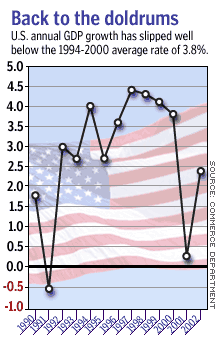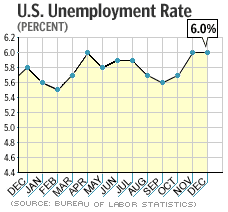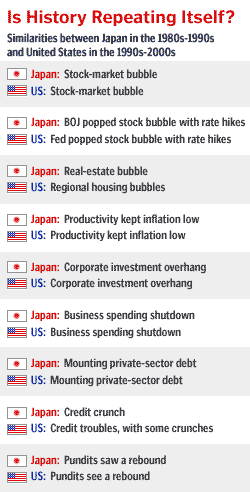NEW YORK (CNN/Money) - The economy was dead in the water in the fourth quarter of 2002 and not much better the rest of the year, and while most economists think stronger growth is right around the corner, some say there's a growing risk the economy could be quite weak for a long time.
The government reported Thursday the world's largest economy grew at a meager 0.7 percent pace in the fourth quarter and just a sluggish 2.4 percent for all of 2002. That followed 0.3 percent growth in 2001, when the economy was in the throes of recession.

But most economists think happy days will soon be here again. According to the consensus view, all that's required for growth to return to the 3.8 percent annual rate it averaged in the late 1990s is for worries about war in Iraq to be cleared up -- either peacefully, or with Saddam Hussein's head on a stake.
With the fog of uncertainty lifted, these analysts say, stock prices will rise, businesses will finally crack open their wallets and hang out "help wanted" signs, and consumers will be able to pick up their spending again.
"A booming economic condition would result," said Sung Won Sohn, chief economist at Wells Fargo & Co., who thinks a short, successful war in Iraq would usher in economic growth at a 4 percent clip by the third quarter.
Post-bubble grit
But not all economists are so sure. The biggest problem, in their view, is not that businesses will sit on their hands until the war blows over. Instead, these corporate managers are still trying to pick up the pieces from the sudden bursting of the stock-market bubble of the late 1990s.
"There is substantial post-bubble grit in the wheels right now," said Lara Rhame, a former economist at the Federal Reserve, now with Brown Brothers Harriman.
During the bubble and the economic boom that accompanied it, many businesses got the idea that profits and stock prices would grow like gangbusters more or less forever. At one point, some widely respected economists thought the Dow Jones industrial average would hit 36,000 by the year 2000 or so.
With these hopes -- and some fears about what would happen to old technology when the calendars flipped to Y2K -- businesses spent money on new technology like it was going out of style, leveraging themselves to the hilt in the process.
When the boom went bust, billions of dollars in stock-market wealth dried up seemingly overnight, along with expectations for unlimited growth. Manufacturers cut back production and cut 1.8 million jobs from their payrolls, and it wasn't long before the rest of the economy followed suit.
The result was a recession that most economists think began in March of 2001 and probably ended late that year or early in 2002.
Even after relatively strong consumer spending pulled the economy out of recession, however, businesses found they had way too much production capacity to warrant further investment.
And with debts high, profits low and prices for manufactured goods falling, cost-conscious businesses were also reluctant to hire back the workers they'd laid off. As a result, the unemployment rate has stayed about the same since December 2001, and seems unlikely to fall back to earth any time soon.

Many economists, in fact, have compared the latest recovery to the "jobless" recovery that followed the 1990-91 recession.
"The best template we have for describing what's going on now is the early-1990s situation," said Rory Robertson, interest-rate strategist at Macquarie Equities USA. "The early-1990s recession and jobless recovery followed the late-1980s boom."
The recession and anemic recovery of the early 1990s lasted about four years. The current recession-weak recovery period has lasted about two years -- so far.
The early 1990s also had an Iraq situation of their own -- and the swift, dramatic success of the United States in that war did little for the economy, Robertson pointed out.
"The Iraq situation is unhelpful, but firms have low profits, low levels of capacity use and no upbeat forecasts about the future, so there's no reason for them to rush out and invest willy nilly" even after the Iraq trouble passes, Robertson said.
And if stock prices fall again this year after three straight years of declines, the economy could be in for a longer period of misery than most economists now expect. Stocks have not fallen for four straight years in the United States since the beginning of the Great Depression.
Even scarier historical comparisons
But the late-1980s boom couldn't hold a candle to the boom of the late 1990s, which was driven by a revolution in technology that promised to forever alter the way U.S. companies did business.
What other U.S. booms had similar characteristics? The railroad-building boom in the late 19th century and the manufacturing boom of the 1920s -- the only other two economic expansions since the Civil War that were triggered by a glut of business investment, as opposed to surging consumer demand.
What sort of busts followed those two booms? Depressions. Long ones.

Still, most forecasts say it's highly unlikely a full-blown depression will follow the late-1990s boom. The United States has put many safeguards in place since the Dust Bowl Days of the 1930s, including insured bank deposits, unemployment insurance, Social Security and Medicare, to name a few.
But there's a more modern example of what can happen to such a safeguarded economy in a post-investment-boom period: Japan. That country's surge led to an asset-price bubble and falling prices, just like the United States' boom.
Japan's post-bubble nightmare -- which has stretched on for the better part of a decade -- has been characterized by chronic economic weakness and a deflationary spiral, in which falling prices hurt corporate profits, leading to layoffs and falling wages, leading to weakness in demand, which leads to falling prices, etc., etc.
"When you have a large debt buildup and a lot of excess capacity, that's not corrected very quickly," said former Fed economist Lacy Hunt, now chief economist at Hoisington Investment Management.
While the optimists point to super-low interest rates and an economic stimulus package Congress is expected to deliver later this year as being sufficient fuel for strong growth, Hunt and other pessimists -- who are in the minority -- point out Japan has fired such weapons at its problems for years without ever triggering a sustainable expansion.
A fiscal stimulus package could pump hundreds of billions of dollars into the economy, but that would be spread out over several years and might barely be enough, in the short term, to offset the crippling effects of belt-tightening tax hikes, layoffs and spending cuts at the state and local level.
And though 12 interest-rate cuts by the Fed in 2001 and 2002 have helped support consumer spending, keeping the economy from falling completely off the table, much of that stimulus has already been absorbed.
"The Fed is trying to do what it can, but the history of the past 200 years is that big booms tend to end badly -- big equity market booms in particular," said Robertson of Macquarie Equities. "The Fed so far has done a magnificent job of holding the show together, but we don't know what effects of the bubble are still in the pipeline."

|

